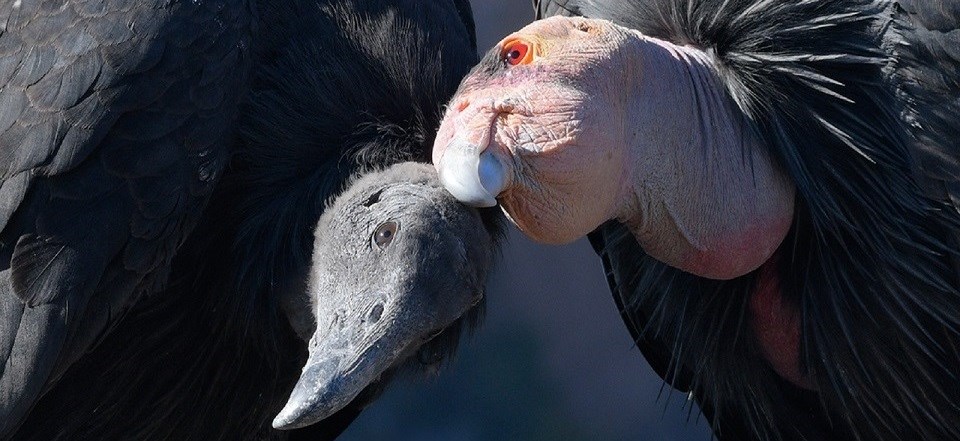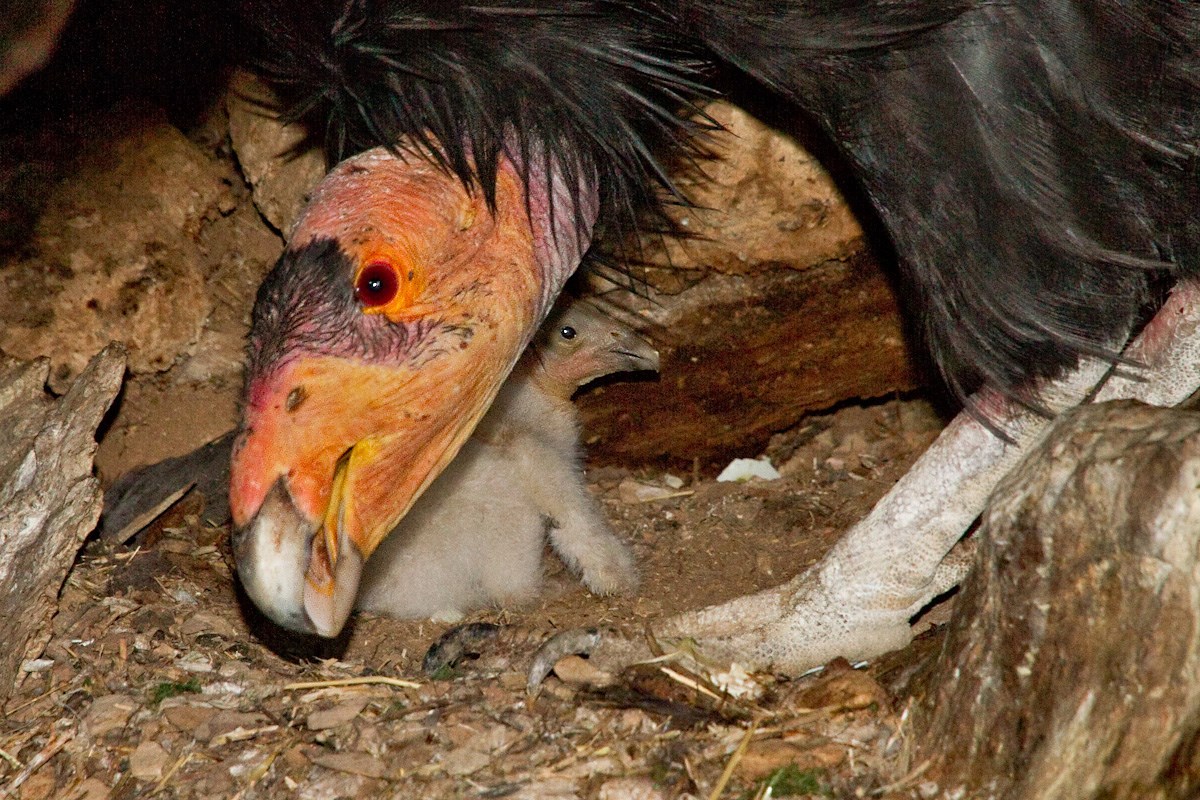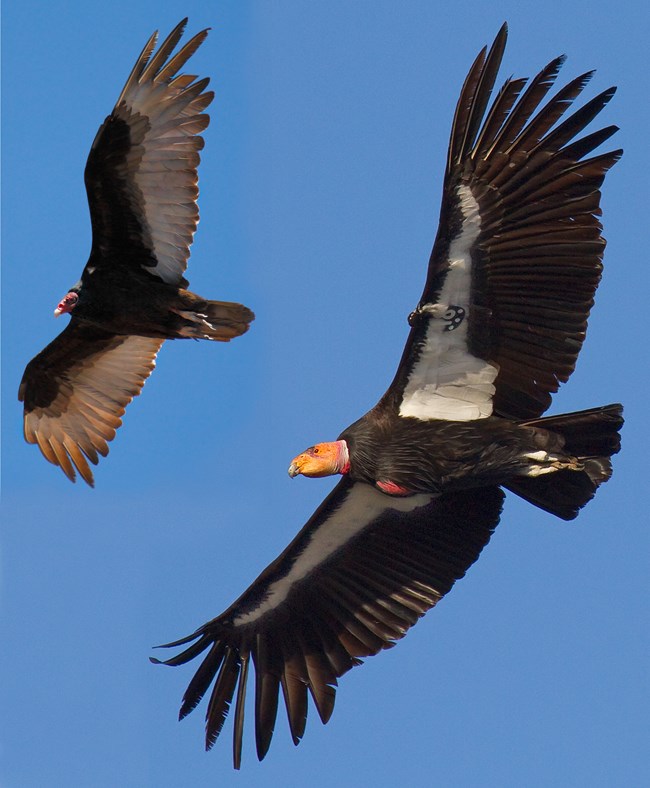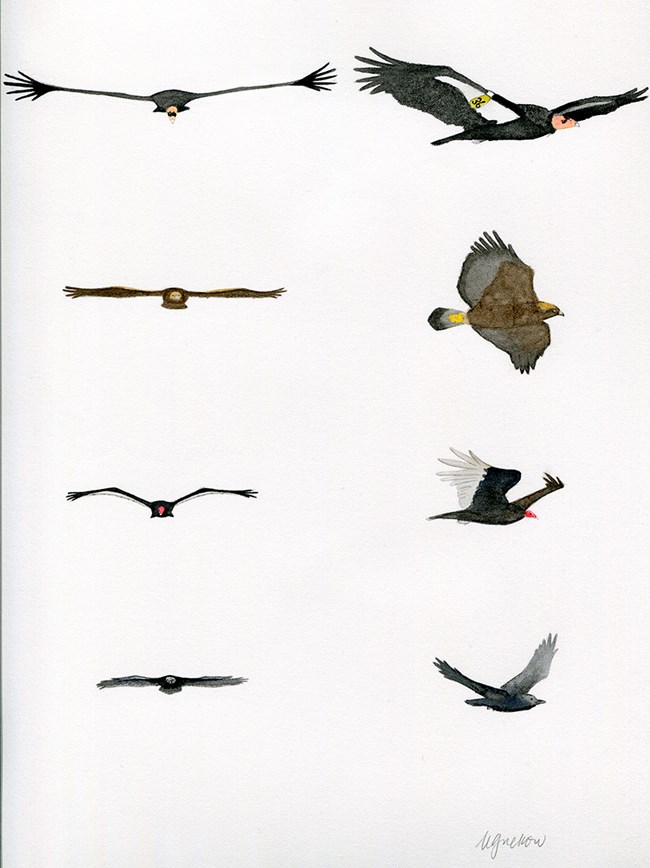
NPS/Gavin Emmons
All About Condors
California condors are the largest land birds in North America, with impressive wingspans of 9.5 feet and weights of around 20 pounds. The exact lifespan of a California condor is unknown, but they are estimated to live over 60 years.
These giants soar on wind thermals high above the ground and use their sharp eyesight to spot food below. Condors are scavengers - they strictly eat dead things, and have been seen feeding on everything from ground squirrels to beached whales. Condors need a big territory that provides adequate food and shelter. They’ve been known to fly up to 200 miles in a single day, using their huge wings to soar long distances with minimal effort. Ideal condor habitat consists of wide expanses of undeveloped land, large trees for roosting, and rocky cliffs or tree cavities for nesting.
Condors are very social animals, and can form strong bonds with each other. They are also very playful and curious birds, and it's not uncommon to see them play fighting, preening each other, or ganging up and inspecting anything new they may find in the area.

NPS/Gavin Emmons
Condor Reproduction
Condors typically - though not always - form long-term bonds with one mate year after year. Mated pairs start the courtship process during the winter months; during this period they will spend nearly all of their time together, preening each other and checking out potential nest sites. Male condors perform a display “dance” for their mate, after which the pair may copulate.
After a few weeks or months of courtship, a mated pair of condors chooses a suitable nesting site. They don’t build nests like many other birds, but instead find cavities in rocky cliffs or in the hollows of large redwood trees. Sometime between January and March, the female condor will lay a single egg in the nest cavity. Both parents take turns incubating the egg for two months until it hatches, and then continue to share parenting duties of their nestling for another six months in the nest until it fledges (learns to fly).
After this intensive parenting effort in the nest, the pair will continue to care for their newly fledged offspring for up to another year. Because of the time and energy it takes to raise one young condor to independence, condors only have one young every two years. The slow reproductive rate of California condors makes these birds more susceptible to population crashes from threats like lead poisoning, and slower to recover their populations after significant mortality events.

NPS/Gavin Emmons
Condor Identification
Condors are striking birds that can be viewed as ugly or majestic, depending on who you ask! Like many other vultures, condors are scavengers that eat only dead animals. They have bald heads, sharp hooked beaks, muscular necks, and large flat feet (instead of the seizing talons that characterize raptors). All of these features help condors feed efficiently on carcasses: their bald heads keep them cleaner during their often-gruesome feeding events, their strong necks and hooked beaks are used for pulling and tearing off chunks of meat, and their flat feet keep them firmly planted on the ground as they tug on their food.
Juvenile condors have black heads. As they age, their skin will slowly start to turn pink; during their “teenage years,” from around ages 3-5, they have a mottled pink and black visage. Once condors reach full maturity at around 6-7 years old, their head will have fully transitioned to a vibrant pink and orange color. Condors also have a thick “ruff” made of short, pointed feathers that they can raise up to fully cover their necks in colder temperatures.
One of the most common questions about condor identification is how to tell them apart from their smaller and much more common relative, the turkey vulture. While both birds are dark in color and have bald heads, they are actually quite different in appearance. Turkey vultures are much smaller, with a wingspan of about 5.5 feet compared to the condor’s 9.5 foot wingspan.

Artist: NPS/Megan Gnekow
If you’re viewing the birds from below, you’ll notice the adult condor’s striking white triangle on the leading edge of the underside of their wings. (This patch is more of a mottled gray color in juvenile condors.) Turkey vultures, on the other hand, have silver-gray colored feathers on the trailing edge of the underside of their wings. You can also see that condors have large pink and orange heads, while turkey vultures have very small red heads.
Because underwing markings can be difficult to see when a bird is flying above you, the way that a condor holds its wings is often one of the best ways to identify it. In flight, condors tend to hold their wings flat and soar without any rocking back and forth. They do flap their wings, but not as often as other birds such as turkey vultures.
Turkey vultures hold their wings in a slight "V" pattern, and will rock side to side in the wind. Turkey vulture flight is often described as wobbly or unstable when compared to that of a condor.
Other large dark birds in the region include golden eagles and common ravens. Refer to the illustrations and photos on this page for differences between these birds and condors in flight.
If you're looking at a bird that is perching, look for a numbered wing tag. All California condors have at least one tag along the leading edge of their wing, and many have two.
Last updated: February 22, 2021
